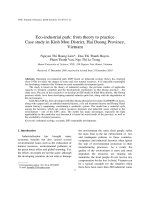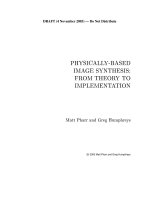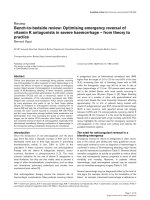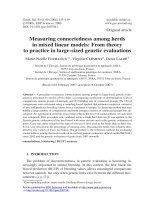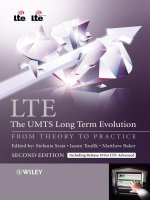Wiley error control coding from theory to practice may 2002 ISBN 047084356x pdf
Bạn đang xem bản rút gọn của tài liệu. Xem và tải ngay bản đầy đủ của tài liệu tại đây (16.94 MB, 252 trang )
ERROR CONTROL CODING
ERROR CONTROL CODING
From Theory to Practice
Peter Sweeney
University of Surrey, Guildford, UK
JOHN WILEY & SONS, LTD
Copyright © 2002
John Wiley & Sons, Ltd., Baffins Lane, Chichester,
West Sussex PO19 1UD, England
Phone (+44) 1243 779777
E-mail (for orders and customer service enquiries): cs-
Visit our Home Page on www.wiley.co.uk or www.wiley.com
All Rights Reserved. No part of this publication may be reproduced, stored in a retrieval system or
transmitted in any form or by any means, electronic, mechanical, photocopying, recording, scanning or
otherwise, except under the terms of the Copyright, Designs and Patents Act 1988 or under the terms of
a licence issued by the Copyright Licensing Agency Ltd., 90 Tottenham Court Road, London W1P 0LP.
UK, without the permission in writing of the Publisher. Requests to the Publisher should be addressed
to the Permissions Department, John Wiley & Sons, Ltd., Baffins Lane, Chichester, West Sussex PO19
1UD, England, or emailed to , or faxed to (+44) 1243 770571.
Other Wiley Editorial Offices
John Wiley & Sons, Inc., 605 Third Avenue, New York, NY 10158–0012, USA
Jossey-Bass, 989 Market Street, San Francisco, CA 94103–1741, USA
Wiley-VCH Verlag GmbH, Pappelallee 3, D-69469 Weinheim, Germany
John Wiley & Sons Australia, Ltd., 33 Park Road, Milton, Queensland 4064, Australia
John Wiley & Sons (Asia) Pte Ltd., 2 Clementi Loop #02–01, Jin Xing Distripark, Singapore 129809
John Wiley & Sons Canada, Ltd., 22 Worcester Road, Etobicoke, Ontario, Canada M9W 1L1
British Library Cataloguing in Publication Data
A catalogue record for this book is available from the British Library
ISBN 0 470 84356 X
Typeset in 10/12pt Times by Kolam Information Services Pvt. Ltd, Pondicherry, India
Printed and bound in Great Britain by TJ International, Padstow, Cornwall
This book is printed on acid-free paper responsibly manufactured from sustainable forestry
in which at least two trees are planted for each one used for paper production.
1
The Principles of Coding in Digital Communications
1.1
1.2
1.3
1.4
1.5
1.6
1.7
Error Control Schemes
Elements of Digital Communication Systems
Source Encoding
Error Control Coding
Modulation
The Channel
Demodulation
1.7.1 Coherent demodulation
1.7.2 Differential demodulation
1.7.3 Soft-decision demodulation
1.8 Decoding
1.8.1 Encoding and decoding example
1.8.2 Soft-decision decoding
1.8.3 Alternative decoding approaches
1.9 Code Performance and Coding Gain
1.10 Information Theory Limits to Code Performance
1.11 Coding for Multilevel Modulations
1.12 Coding for Burst-Error Channels
1.13 Multistage Coding
1.14 Error Detection Based Methods
1.14.1 ARQ strategies
1.14.2 Error concealment
1.14.3 Error detection and correction capability of block
codes
1.15 Selection of Coding Scheme
1.15.1 General considerations
1.15.2 Data structure
1.15.3 Information type
1.15.4 Data rate
1.15.5 Real time data processing
1.15.6 Power and bandwidth constraints
1
1
2
2
3
5
7
8
8
9
10
11
12
14
15
16
18
21
22
24
24
24
26
26
27
27
28
29
29
30
30
vi
2
CONTENTS
1.15.7 Channel error mechanisms
1.15.8 Cost
1.16 Conclusion
1.17 Exercises
1.18 References
31
31
32
33
34
Convolutional Codes
35
2.1
2.2
2.3
2.4
2.5
2.6
2.7
2.8
2.9
35
35
36
37
38
39
39
41
42
42
42
45
45
51
53
55
56
57
62
64
64
66
2.10
2.11
2.12
2.13
2.14
2.15
2.16
2.17
2.18
2.19
Introduction
General Properties of Convolutional Codes
Generator Polynomials
Terminology
Encoder State Diagram
Distance Structure of Convolutional Codes
Evaluating Distance and Weight Structures
Maximum Likelihood Decoding
Viterbi Algorithm
2.9.1 General principles
2.9.2 Example of viterbi decoding
2.9.3 Issues arising
Practical Implementation of Viterbi Decoding
Performance of Convolutional Codes
Good Convolutional Codes
Punctured Convolutional Codes
Applications of Convolutional Codes
Codes for Multilevel Modulations
Sequential Decoding
Conclusion
Exercises
References
3 Linear Block Codes
3.1
3.2
3.3
3.4
3.5
3.6
3.7
3.8
3.9
3.10
3.11
3.12
3.13
3.14
3.15
Introduction
Mathematics of Binary Codes
Parity Checks
Systematic Codes
Minimum Hamming Distance of a Linear Block Code
How to Encode - Generator Matrix
Encoding with the Parity Check Matrix
Decoding with the Parity Check Matrix
Decoding by Standard Array
Codec Design for Linear Block Codes
Modifications to Block Codes
Dorsch Algorithm Decoding
Conclusion
Exercises
References
67
67
67
68
69
70
70
71
73
75
76
78
81
83
83
85
CONTENTS
4
Cyclic Codes
4.1
4.2
4.3
4.4
4.5
4.6
4.7
4.8
4.9
4.10
4.11
4.12
4.13
4.14
4.15
4.16
4.17
4.18
4.19
4.20
4.21
4.22
5
Introduction
Definition of a Cyclic Code
Example of a Cyclic Code
Polynomial Representation
Encoding by Convolution
Establishing the Cyclic Property
Deducing the Properties of a Cyclic Code
Primitive Polynomials
Systematic Encoding of Cyclic Codes
Syndrome of a Cyclic Code
Implementation of Encoding
Decoding
Decoder Operation
Multiple-Error Correction
Example of Multiple-Error Correction
Shortened Cyclic Codes
Expurgated Cyclic Codes
BCH Codes
Cyclic Codes for Burst-Error Correction
Conclusion
Exercises
References
vii
87
87
87
88
88
89
90
91
92
93
94
94
96
100
100
101
103
104
106
107
110
110
112
Finite Field Arithmetic
113
5.1
5.2
5.3
5.4
5.5
5.6
113
113
114
115
117
119
119
120
120
120
120
121
121
123
124
125
127
129
131
132
134
5.7
5.8
5.9
5.10
5.11
5.12
5.13
5.14
5.15
Introduction
Definition of a Finite Field
Prime Size Finite Field GF(p)
Extensions to the Binary Field - Finite Field GF(2m)
Polynomial Representation of Finite Field Elements
Properties of Polynomials and Finite Field Elements
5.6.1 Roots of a polynomial
5.6.2 Minimum polynomial
5.6.3 Order of an element
5.6.4 Finite field elements as roots of a polynomial
5.6.5 Roots of an irreducible polynomial
5.6.6 Factorization of a polynomial
Fourier Transform over a Finite Field
Alternative Visualization of Finite Field Fourier Transform
Roots and Spectral Components
Fast Fourier Transforms
Hardware Multipliers using Polynomial Basis
Hardware Multiplication using Dual Basis
Hardware Multiplication using Normal Basis
Software Implementation of Finite Field Arithmetic
Conclusion
viii
CONTENTS
5.16 Exercises
5.17 References
6 BCH Codes
6.1
6.2
6.3
6.4
6.5
6.6
6.7
6.8
6.9
6.10
6.11
6.12
6.13
6.14
6.15
7
Reed Solomon Codes
7.1
7.2
7.3
7.4
7.5
7.6
7.7
7.8
7.9
7.10
7.11
7.12
7.13
7.14
7.15
7.16
8
Introduction
Specifying Cyclic Codes by Roots
Definition of a BCH Code
Construction of Binary BCH Codes
Roots and Parity Check Matrices
Algebraic Decoding
BCH Decoding and the BCH Bound
Decoding in the Frequency Domain
Decoding Examples for Binary BCH Codes
Polynomial Form of the Key Equation
Euclid's Method
Berlekamp—Massey Algorithm
Conclusion
Exercises
References
Introduction
Generator Polynomial for a Reed Solomon Code
Time Domain Encoding for Reed Solomon Codes
Decoding Reed Solomon Codes
Reed Solomon Decoding Example
Frequency Domain Encoded Reed Solomon Codes
Further Examples of Reed Solomon Decoding
Erasure Decoding
Example of Erasure Decoding of Reed Solomon Codes
Generalized Minimum Distance Decoding
Welch—Berlekamp Algorithm
Singly Extended Reed Solomon Codes
Doubly Extended Reed Solomon Codes
Conclusion
Exercises
References
Performance Calculations for Block Codes
8.1
8.2
8.3
8.4
8.5
8.6
8.7
Introduction
Hamming Bound
Plotkin Bound
Griesmer Bound
Singleton Bound
Gilbert—Varsharmov Bound
Error Detection
135
136
137
137
137
138
138
140
143
144
146
147
149
149
151
152
153
154
CONTENTS
8.8
8.9
8.10
8.11
8.12
8.13
8.14
8.15
8.16
8.17
Random-Error Detection Performance of Block Codes
Weight Distributions
Worst Case Undetected Error Rate
Burst-Error Detection
Examples of Error Detection Codes
Output Error Rates using Block Codes
Detected Uncorrectable Errors
Application Example - Optical Communications
Conclusion
Exercises
9 Multistage Coding
9.1
9.2
9.3
9.4
9.5
9.6
9.7
9.8
9.9
9.10
Introduction
Serial Concatenation
Serial Concatenation using Inner Block Code
9.3.1 Maximal length codes
9.3.2 Orthogonal codes
9.3.3 Reed Muller codes
9.3.4 High rate codes with soft-decision decoding
Serial Concatenation using Inner Convolutional Code
Product codes
Generalized Array Codes
Applications of Multistage Coding
Conclusion
Exercises
References
10 Iterative Decoding
10.1
10.2
10.3
10.4
10.5
10.6
10.7
10.8
10.9
10.10
10.11
10.12
10.13
10.14
10.15
10.16
Index
Introduction
The BCJR Algorithm
BCJR Product Code Example
Use of Extrinsic Information
Recursive Systematic Convolutional Codes
MAP Decoding of RSC Codes
Interleaving and Trellis Termination
The Soft-Output Viterbi Algorithm
Gallager Codes
Serial Concatenation with Iterative Decoding
Performance and Complexity Issues
Application to Mobile Communications
Turbo Trellis-Coded Modulation
Conclusion
Exercises
References
ix
181
182
184
185
185
186
188
190
192
192
195
195
195
196
196
197
198
198
199
200
203
206
208
208
209
211
211
211
212
214
215
217
220
222
225
231
232
233
233
235
235
236
239
This page intentionally left blank
1
The principles of coding in digital
communications
1.1 ERROR CONTROL SCHEMES
Error control coding is concerned with methods of delivering information from a
source to a destination with a minimum of errors. As such it can be seen as a branch
of information theory and traces its origins to Shannon's work in the late 1940s.
The early theoretical work indicates what is possible and provides some insights
into the general principles of error control. On the other hand, the problems
involved in finding and implementing codes have meant that the practical effects
of employing coding are often somewhat different from what was originally
expected.
Shannon's work showed that any communication channel could be characterized
by a capacity at which information could be reliably transmitted. At any rate of
information transmission up to the channel capacity, it should be possible to transfer
information at error rates that can be reduced to any desired level. Error control can
be provided by introducing redundancy into transmissions. This means that more
symbols are included in the message than are strictly needed just to convey the
information, with the result that only certain patterns at the receiver correspond to
valid transmissions. Once an adequate degree of error control has been introduced,
the error rates can be made as low as required by extending the length of the code,
thus averaging the effects of noise over a longer period.
Experience has shown that to find good long codes with feasible decoding schemes
is more easily said than done. As a result, practical implementations may concentrate
on the improvements that can be obtained, compared with uncoded communications. Thus the use of coding may increase the operational range of a communication
system, reduce the error rates, reduce the transmitted power requirements or obtain a
blend of all these benefits.
Apart from the many codes that are available, there are several general techniques
for the control of errors, and the choice will depend on the nature of the data
and the user's requirements for error-free reception. The most complex techniques
fall into the category of forward error correction, where it is assumed that a code
capable of correcting any errors will be used. Alternatives are to detect errors and
request retransmission, which is known as retransmission error control, or to use
2
ERROR CONTROL CODING
inherent redundancy to process the erroneous data in a way that will make the errors
subjectively important, a method known as error concealment.
This chapter first looks at the components of a digital communication system.
Sections 1.3 to 1.8 then look in more detail at each of the components. Section 1.8
gives a simple example of a code that is used to show how error detection and
correction may in principle be achieved. Section 1.9 discusses the performance of
error correcting codes and Section 1.10 looks at the theoretical performance available. A number of more advanced topics are considered in Sections 1.11 to 1.14,
namely coding for bandwidth-limited conditions, coding for burst errors, multistage
coding (known as concatenation) and the alternatives to forward error correction.
Finally, Section 1.15 summarizes the various considerations in choosing a coding
scheme.
1.2 ELEMENTS OF DIGITAL COMMUNICATION
SYSTEMS
A typical communication system incorporating coding is shown in Figure 1.1. Error
control coding is applied after the source information is converted into digital format
by the source encoder. The separation between coding and modulation is conventional, although it will be found later that there are instances where the two must be
designed together. At the receiver, the operations are carried out in reverse order
relative to the transmitter.
The functions are described in more detail in the following sections.
Modul
Error control
encoder
Source
encoder
1
„
-„ j
information
C
h
a
n
n
e
1
T
Demodu IaU"
received
Error control
decoder
Source
decoder
Figure 1.1 Coded communication system
1.3 SOURCE ENCODING
Information is given a digital representation, possibly in conjunction with techniques
for removal of any inherent redundancy within the data. The amount of information
THE PRINCIPLES OF CODING IN DIGITAL COMMUNICATIONS
3
contained in any message is defined in terms of the probability p that the message is
selected for transmission. The information content H, measured in bits, is given by
H = log2(l/p)
For example, a message with a 1 % chance of being selected would contain
approximately 6.64 bits of information.
If there are M messages available for selection and the probability of message m is
denoted pm, the average amount of information transferred in a message is
subject to the constraint that Y^m=Q Pm = IIf the messages are equiprobable, i.e. pm = 1/M, then the average information
transferred is just Iog2 (M). This is the same as the number of bits needed to represent
each of the messages in a fixed-length coding scheme. For example, with 256
messages an 8-bit code can be used to represent any messages and, if they are equally
likely to be transmitted, the information content of any message is also 8 bits.
If the messages are not equally likely to be transmitted, then the average information content of a message will be less than Iog2 (M) bits. It is then desirable to find
a digital representation that uses fewer bits, preferably as close as possible to the
average information content. This may be done by using variable length codes such
as Huffman codes or arithmetic codes, where the length of the transmitted sequence
matches as closely as possible the information content of the message. Alternatively,
for subjective applications such as speech, images or video, lossy compression techniques can be used to produce either fixed-length formats or variable-length formats.
The intention is to allow the receiver to reconstitute the transmitted information into
something that will not exactly match the source information, but will differ from it
in a way that is subjectively unimportant.
1.4 ERROR CONTROL CODING
Error control coding is in principle a collection of digital signal processing techniques
aiming to average the effects of channel noise over several transmitted signals. The
amount of noise suffered by a single transmitted symbol is much less predictable than
that experienced over a longer interval of time, so the noise margins built into the
code are proportionally smaller than those needed for uncoded symbols.
An important part of error control coding is the incorporation of redundancy into
the transmitted sequences. The number of bits transmitted as a result of the error
correcting code is therefore greater than that needed to represent the information.
Without this, the code would not even allow us to detect the presence of errors and
therefore would not have any error controlling properties. This means that, in theory,
any incomplete compression carried out by a source encoder could be regarded as
having error control capabilities. In practice, however, it will be better to compress the
4
ERROR CONTROL CODING
source information as completely as possible and then to re-introduce redundancy in a
way that can be used to best effect by the error correcting decoder.
The encoder is represented in Figure 1.2. The information is formed into frames to
be presented to the encoder, each frame consisting of a fixed number of symbols. In
most cases the symbols at the input of the encoder are bits; in a very few cases
symbols consisting of several bits are required by the encoder. The term symbol will
be used to maintain generality.
To produce its output, the encoder uses the symbols in the input frame and
possibly those in a number of previous frames. The output generally contains more
symbols than the input, i.e. redundancy has been added. A commonly used descriptor of a code is the code rate (R) which is the ratio of input to output symbols in one
frame. A low code rate indicates a high degree of redundancy, which is likely to
provide more effective error control than a higher rate, at the expense of reducing the
information throughput.
If the encoder uses only the current frame to produce its output, then the code is
called a (n, k) block code, with the number of input symbols per frame designated k
and the corresponding number of output symbols n. If the encoder remembers a
number of previous frames and uses them in its algorithm, then the code is called a
tree code and is usually a member of a subset known as convolutional codes. In this
case the number of symbols in the input frame will be designated k0 with n0 symbols
in the output frame. The encoder effectively performs a sliding window across the
data moving in small increments that leave many of the same symbols still within the
encoder window, as shown in Figure 1.3. The total length of the window, known as
0
f
s
1
2
Output
buffer
k-\
n-\
Figure 1.2
Encoder
v-bit encoder memory
input
frame
AT-bit encoder constraint length
Figure 1.3 Sliding window for tree encoder
THE PRINCIPLES OF CODING IN DIGITAL COMMUNICATIONS
5
the input constraint length (K), consists of the input frame of k0 symbols plus the
number of symbols in the memory. This latter parameter is known as memory
constraint length (v).
In more complex systems the encoding may consist of more than one stage and
may incorporate both block and convolutional codes and, possibly, a technique
known as interleaving. Such systems will be considered in later sections.
One property that will be shared by all the codes in this book is linearity. If we
consider a linear system we normally think in terms of output being proportional to
input (scaling property). For a linear system we can also identify on the output the
sum of the separate components deriving from the sum of two different signals at the
input (superposition property). More formally, if the system performs a function/on
an
input to produce its output, thenf(cx)= c x f(x) (scaling)
f(x + y) =f(x) +f(y)
(superposition)
where c is a scalar quantity, x and y are vectors.
Now the definition of a linear code is less restrictive than this, in that it does not
consider the mapping from input to output, but merely the possible outputs from the
encoder. In practice, however, a linear system will be used to generate the code and so
the previous definition will apply in all real-life cases.
The standard definition of a linear code is as follows:
• Multiplying a code sequence by a valid scalar quantity produces a code sequence.
• Adding two code sequences produces a code sequence.
The general rules to be followed for multiplication and addition are covered in
Chapter 5 but for binary codes, where the only valid scalars are 0 and 1, multiplication of a value by zero always produces zero and multiplication by 1 leaves the
value unchanged. Addition is carried out as a modulo-2 operation, i.e. by an exclusive-OR function on the values.
A simple example of a linear code will be given in Section 1.8. Although the
definition of a linear code is less restrictive than that of a linear system, in practice
linear codes will always be produced by linear systems. Linear codes must contain the
all-zero sequence, because multiplying any code sequence by zero will produce an allzero result.
1.5 MODULATION
The modulator can be thought of as a kind of digital to analogue converter, preparing
the digital code-stream for the real, analogue world. Initially the digital stream is put
into a baseband representation, i.e. one in which the signal changes at a rate comparable with the rate of the digital symbols being represented. A convenient representation is the Non Return to Zero (NRZ) format, which represents bits by signal levels of
+ V or — V depending on the bit value. This is represented in Figure 1.4.
ERROR CONTROL CODING
+K,
time
1 2 3 4 5 6 7 8 91 0
Figure 1.4 Binary NRZ stream
Although it would be possible to transmit this signal, it is usual to translate it into a
higher frequency range. The reasons for this include the possibility of using different
parts of the spectrum for different transmissions and the fact that higher frequencies
have smaller wavelengths and need smaller antennas. For most of this text, it will be
assumed that the modulation is produced by multiplying the NRZ baseband signal by
a sinusoidal carrier whose frequency is chosen to be some multiple of the transmitted
bit rate (so that a whole number of carrier cycles are contained in a single-bit interval).
As a result, the signal transmitted over a single-bit interval is either the sinusoidal
carrier or its inverse. This scheme is known as Binary Phase Shift Keying (BPSK).
It is possible to use a second carrier at 90° to the original one, modulate it and add
the resulting signal to the first. In other words, if the BPSK signal is ± cos (2nfct),
where fc is the carrier frequency and t represents time, the second signal is
± sin (2nfci) and the resultant is
s(t) = V2cos(2nfct + in/4) / = -3, - 1, + 1, + 3
This is known as Quadriphase Shift Keying (QPSK) and has the advantage over
BPSK that twice as many bits can be transmitted in the same time and the same
bandwidth, with no loss of resistance to noise. The actual bandwidth occupied by the
modulation depends on implementation details, but is commonly taken to be 1 Hz
for one bit per second transmission rate using BPSK or 0.5 Hz using QPSK.
A phase diagram of QPSK is shown in Figure 1.5. The mapping of the bit values
onto the phases assumes that each of the carriers is independently modulated using
alternate bits from the coded data stream. It can be seen that adjacent points in the
diagram differ by only one bit because the phase of only one of the two carriers has
changed. A mapping that ensures that adjacent points differ by only one bit is known
as Gray Coding.
01
sin(2nfct)
11
cos(2nfct)
00
10
Figure 1.5 Gray-coded QPSK phase diagram
THE PRINCIPLES OF CODING IN DIGITAL COMMUNICATIONS
7
Other possible modulations include Frequency Shift Keying (FSK), in which the
data determines the frequency of the transmitted signal. The advantage of FSK is
simplicity of implementation, although the resistance to noise is less than BPSK or
QPSK. There are also various modulations of a type known as Continuous Phase
Modulation, which minimize phase discontinuities between transmitted waveforms to
improve the spectral characteristics produced by nonlinear power devices.
In bandwidth-limited conditions, multilevel modulations may be used to achieve
higher bit rates within the same bandwidth as BPSK or QPSK. In M-ary Phase Shift
Keying (MPSK) a larger number of transmitted phases is possible. In Quadrature
Amplitude Modulation (QAM) a pair of carriers in phase quadrature are each given
different possible amplitudes before being added to produce a transmitted signal with
different amplitudes as well as phases. QAM has more noise resistance than equivalent MPSK, but the variations in amplitude may cause problems for systems involving nonlinear power devices. Both QAM and MPSK require special approaches to
coding which consider the code and the modulation together.
1.6 THE CHANNEL
The transmission medium introduces a number of effects such as attenuation, distortion, interference and noise, making it uncertain whether the information will be
received correctly. Although it is easiest to think in terms of the channel as introducing errors, it should be realized that it is the effects of the channel on the demodulator that produce the errors.
The way in which the transmitted symbols are corrupted may be described using
the following terms:
• Memoryless channel - the probability of error is independent from one symbol to
the next.
• Symmetric channel - the probability of a transmitted symbol value i being received
as a value j is the same as that of a transmitted symbol value j being received as
i, for all values of i and j. A commonly encountered example is the binary
symmetric channel (BSC) with a probability p of bit error, as illustrated in
Figure 1.6.
1-p
Figure 1.6 Binary symmetric channel
8
ERROR CONTROL CODING
• Additive White Gaussian Noise (AWGN) channel - a memoryless channel in
which the transmitted signal suffers the addition of wide-band noise whose amplitude is a normally (Gaussian) distributed random variable.
• Bursty channel - the errors are characterized by periods of relatively high symbol
error rate separated by periods of relatively low, or zero, error rate.
• Compound (or diffuse) channel - the errors consist of a mixture of bursts and
random errors. In reality all channels exhibit some form of compound behaviour.
Many codes work best if errors are random and so the transmitter and receiver
may include additional elements, an interleaver before the modulator and a deinterleaver after the demodulator to randomize the effects of channel errors. This will be
discussed in Section 1.12.
1.7 DEMODULATION
1.7.1
Coherent demodulation
The demodulator attempts to decide on the values of the symbols that were transmitted and pass those decisions on to the next stage. This is usually carried out by
some sort of correlation with replicas of possible transmitted signals. Consider, for
example, the case of BPSK. The correlation is with a single fixed phase of the carrier,
producing either a positive or a negative output from the detector. In the absence of
noise, the detected signal level can be taken as ±\/E~r where Er is the energy in each
received bit. The effect of an AWGN channel will be to add a noise level n sampled
from a Gaussian distribution of zero mean and standard deviation a. The probability
density is given by
Gaussian noise has a flat spectrum and the noise level is often described by its
Single-sided Noise Power Spectral Density, which is written N0. The variance,
considered that there is a total noise variance of N0 with half of this acting either in
phase or in antiphase to the replica and the other half in phase quadrature, therefore
not affecting the detector. The performance of Gray-coded QPSK is therefore exactly
the same as BPSK because the two carriers can be demodulated as independent
BPSK signals, each affected by independent Gaussian noise values with the same
standard deviation.
The demodulator will make its decision based on the sign of the detected signal.
If the received level is positive, it will assume that the value corresponding to the
replica was transmitted. If the correlation was negative, it will assume that the other
value was transmitted. An error will occur, therefore, if the noise-free level is -\fEr
THE PRINCIPLES OF CODING IN DIGITAL COMMUNICATIONS
9
and a noise value greater than +\fEr is added, or if the noise-free level is +\fE~r and a
noise value less than —-/fir is added. Considering only the former case, we see that
the probability of error is just the probability that the Gaussian noise has a value
greater than +^/Er•.
cc
p = -4=
f e-"2^° dn
Substituting t — n/^JN® gives
oc
,
where
—
f
v^J
7
The function erfc(x) is known as the complementary error function and its values
are widely available in tabulated form. Note that the maximum value of erfc(x) is 1 .0,
so that the maximum bit error probability is 0.5. This makes sense because we could
guess bit values with 50% probability without attempting to receive them at all.
1.7.2
Differential demodulation
One further complication is commonly encountered with BPSK or QPSK transmissions. In the absence of other information, it is impossible for the receiver to
determine absolute phase so as to know which of the two phases represents the
value 0 and which represents 1. This is because delay in the transmission path, which
is equivalent to phase shift, will not be known. The representation of bit values is
therefore often based on the difference between phases. Depending on the precise
demodulation method, this is known either as Differentially Encoded Phase Shift
Keying (DEPSK) or as Differential Phase Shift Keying (DPSK). The two are identical
from the modulation point of view, with the bit value 0 normally resulting in a
change of phase and the bit value 1 resulting in the phase remaining the same. The
receiver may not know absolute phase values, but should be able to tell whether the
phase has changed or remained the same. The differences in the demodulator
implementation may be summarized as follows:
• DEPSK – The demodulator maintains a replica of one of the two carrier phases
and correlates the received signal with this replica as for normal PSK. It then
compares the sign of the correlation with the previous correlation value; a change
of sign indicates data bit 0 and the same sign indicates data bit 1. Compared with
PSK, there will now be a bit error either when the phase is received wrongly and the
10
ERROR CONTROL CODING
previous phase was correct or when the phase is received correctly and the previous
phase was wrong. Thus noise that would cause a single-bit error in a BPSK
demodulator will cause two consecutive bit errors in the DEPSK demodulator
and the bit error probability is approximately twice the above BPSK expression.
• DPSK - The demodulator uses the previously received phase as the replica for the
next bit. Positive correlation indicates data value 1, negative correlation indicates
data value 0. The bit errors again tend to correlate in pairs, but the overall
performance is worse. In fact the bit error probability of DPSK follows a different
shape of curve:
1.7.3
Soft-decision demodulation
In some cases the demodulator's decision will be easy; in other cases it will be
difficult. In principle if errors are to be corrected it is better for the demodulator to
pass on the information about the certainty of its decisions because this might assist
the decoder in pinpointing the positions of the likely errors; this is called soft-decision
demodulation. We could think of it as passing on the actual detected level as a real
number, although in practice it is likely to have some sort of quantization. Eight-level
quantization is found to represent a good compromise between complexity and
performance.
Since the purpose of soft decisions is to assist decoding, it is useful to relate the
demodulator output to probabilistic measures of performance. One commonly
adopted measure is known as the log-likelihood ratio, defined as log[/Kl|r/)//?(0|r,)].
This metric is required in an important decoding method to be described in Chapter
10 and can be used for other decoding methods too. The computation of the value
may appear difficult, however we note that
Assuming that values 0 and 1 are equiprobable, log[p(l)/p(Q)] = 0 and so the
assigned bit value for received level r, is equal to log[/?(ri|l)//Kr/|0)]- This value can
be calculated given knowledge of the signal level and the noise statistics. Note that it
ranges from — oo (certain 0) to +00 (certain 1).
Assuming that we have Gaussian noise, the probability density function at a
received value ri from a noise-free received value x is
The appropriate values of x for bit values 1 and 0 are +\TEr and —\fEr- Thus the
2 2
log-likelihood ratio i s proportional t o
THE PRINCIPLES OF CODING IN DIGITAL COMMUNICATIONS
11
Now
log
^.,-(n-\
#o
No
Hence we find that
r
V /[ * / I
"IV
">
4r
I
In other words, the log-likelihood ratio is linear with the detected signal level and is
equal to the channel E r /N 0 , multiplied by four times the detected signal (normalized
to make the noise-free levels equal to -f/ — 1).
Note that the mapping adopted here from code bit values to detected demodulator
levels is opposite to that conventionally used in other texts. The conventional
mapping is that bit value 0 maps onto +1 and bit value 1 onto — 1 . The advantage
is that the exclusive-OR operation in the digital domain maps onto multiplication in
the analog domain. The disadvantage is the potential confusion between bit value
1 and analog value +1.
Because of the linearity of the log-likelihood ratio, the quantization boundaries of
the demodulator can be set in roughly linear steps. The question remains, however, as
to what size those steps should be. It can be shown that, for Q-level quantization, the
optimum solution is one that minimizes the value of
where p(jlc) represents the probability of a received value j given that symbol c was
transmitted. Massey [1] described an iterative method of finding the optimum solution
with nonuniform arrangement of boundaries, but the above value can easily be
calculated for different linear spacings to find an approximate optimum. For example,
with E r / N 0 around 2 dB, it is found that uniformly spaced quantization boundaries are
close to optimum if the spacing is 1/3, i.e. the boundaries are placed at —1, — 2/3
-1/3,0, +1/3, + 2/3, + 1. The use of such a scheme will be described in Section 1.8.2.
1.8 DECODING
The job of the decoder is to decide what the transmitted information was. It has the
possibility of doing this because only certain transmitted sequences, known as codewords, are possible and any errors are likely to result in reception of a non-code
sequence. On a memoryless channel, the best strategy for the decoder is to compare
the received sequence with all the codewords, taking into account the confidence in
the received symbols, and select the codeword which is closest to the received
sequence as discussed above. This is known as maximum likelihood decoding.
12
1.8.1
ERROR CONTROL CODING
Encoding and decoding example
Consider, for example, the block code shown in Table 1.1. This code is said to be
systematic, meaning that the codeword contains the information bits and some other
bits known as parity checks because they have been calculated in some way from the
information. It can be seen that any codeword differs in at least three places from any
other codeword. This value is called the minimum Hamming distance or, more briefly,
minimum distance of the code. Consequently, if a single bit is wrong, the received
sequence is still closer to the transmitted codeword, but if two or more bits are
wrong, then the received sequence may be closer to one of the other codewords.
This code is linear and for any linear code it is found that the distance structure is
the same from any codeword. For this example, starting from any codeword there are
two sequences at a distance of 3 and one at a distance of 4. Thus the code properties
and the error-correction properties are independent of the sequence transmitted. As a
consequence, the minimum distance of the code can be found by comparing each
nonzero sequence with the all-zero sequence, finding the nonzero codeword with the
smallest number nonzero symbols. The count of nonzero symbols is known as the
weight of the sequence and the minimum weight of the code is equal to the minimum
distance.
Let us now assume that information 10 has been selected and that the sequence
10101 is therefore transmitted. Let us also assume that the received bits are harddecision quantized. If the sequence is received without error, it is easy to identify it in
the table and to decode. If there are errors, however, things will be more difficult and
we need to measure the number of differences between the received sequence and
each codeword. The measure of difference between sequences is known as Hamming
distance, or simply as distance between the sequences. Consider first the received
sequence 00101. The distance to each codeword is shown in Table 1.2.
In this case we can see that we have a clear winner. The transmitted sequence has
been selected as the most likely and the decoding is correct.
Table 1.1 Example block code
Information
Codeword
00
00000
01
10
11
01011
10101
11110
Table 1.2 Distances for sequence 00101
Codeword
00000
01011
10101
11110
Distance
2
3
1
4
THE PRINCIPLES OF CODING IN DIGITAL COMMUNICATIONS
13
The previous example had an error in an information bit, but the result will be the
same if a parity check bit is wrong. Consider the received sequence 10111. The
distances are shown in Table 1.3. Again the sequence 10101 is chosen. Further
examples are left to the reader, but it will be found that any single-bit error can be
recovered, regardless of the position or the codeword transmitted.
Now let us consider what happens if there are two errors. It will be found that there
are two possibilities.
Firstly, consider the received sequence 11111. The distances are shown in Table 1.4.
In this case, the codeword 11110 is chosen, which is wrong. Moreover, the decoder has
decided that the final bit was wrong when in fact it was correct. Because there are at
least three differences between any pair of codewords, the decoder has made an extra
error on top of the two made by the channel, in effect making things worse.
Finally, consider the received sequence 11001, whose distances to the codewords
are shown in Table 1.5. In this case, there are two problems in reaching a decision.
The first, and obvious, problem is that there is no clear winner and, in the absence of
other information, it would be necessary to choose randomly between the two most
likely codewords. Secondly, we predicted at the outset that only single errors would
be correctable and the decoder may have been designed in such a way that it refuses
to decode if there is no codeword within a distance 1 of the received sequence. The
likely outcome for this example, therefore, is that the decoder will be unable to
Table 1.3 Distances for sequence 10111
Codeword
00000
01011
10101
11110
Distance
4
3
1
2
Table 1.4 Distances for sequence 11111
Codeword
00000
01011
10101
11110
Distance
5
2
2
1
Table 1.5 Distances for sequence 11001
Codeword
00000
01011
10101
11110
Distance
3
2
2
3
14
ERROR CONTROL CODING
choose the most likely transmitted codeword and will indicate to the user the
presence of detected uncorrectable errors. This is an important outcome that may
occur frequently with block codes.
1.8.2
Soft-decision decoding
The probability that a sequence c of length n was transmitted, given the received
sequence r, is OJ'rJXc/lr,-). We wish to maximize this value over all possible code
sequences. Alternatively, and more conveniently, we take logarithms and find the
maximum of J]/=o l°§[/Kc/lr/)]- This can be carried out by a correlation process,
which is a symbol-by-symbol multiplication and accumulation, regarding the code
bits as having values +1 or — 1. Therefore we would be multiplying the assigned
probability by 1 for a code bit of 1 and by -1 for a code bit of 0. For hard decisions, a
codeword of length n at a distance d from the received sequence would agree in n — d
places and disagree in d places with the received sequence, giving a correlation metric
of 2n— d. Obviously choosing the codeword to maximize this metric would yield the
same decoding result as the minimum distance approach.
Even with soft decisions, we can adopt a minimum distance view of decoding and
minimize 53/=o {1 ~ 1°8 [/>(c/lr»)] }• The correlation and minimum distance approaches
are again identical provided we have an appropriate measure of distance. If the
received bits are given values vi equal to log[/?(l|r/)], then the distance to a bit value
1 is 1 — v/, the distance to a bit value 0 is v, and we maximize probability by minimizing
this measure of distance over all codewords.
The maximization of probability can also be achieved by maximizing some other
function that increases monotonically with it. This is the case for the log-likelihood
ratio log [p(\ |r/)/XO|r,-)]. To decode, we can maximize £], c, log[p(r,11 )//?(r,| 1)] where
Ci is taken as having values ± 1. This again corresponds to carrying out a correlation
of received log-likelihood ratios with code sequences.
As discussed in Section 1.7.3, it is likely that the received levels will be quantized.
For 8-level quantization, it might be convenient to use some uniform set of metric
values depending on the range within which the detected bit falls. Such a scheme is
shown in Figure 1.7.
Bearing in mind the fact that the log-likelihood ratio is linear with the analog
detected level from the demodulator, then the only deviation from an ideal 8-level
quantized
metric value
-3.5
-2,,-,,
-1
"*
-0.5
+0.5
+ 1.5
+2.5
+3.5
0
normalized
detected value
Figure 1.7 Quantization boundaries for soft-decision demodulation
15
quantization is that the end categories (000 and 111) extend to — oo and +00 and
therefore should have larger metrics associated with them. The effect on performance, however, is negligible. For E r / N 0 = 2 dB, the optimum soft-decision metric
values associated with this quantization arrangement are —3.85, —2.5, —1.5, —0.5,
+0.5, +1.5, +2.5, +3.85. Therefore the proposed metrics of —3.5 to +3.5 are very
close to optimum.
The assigned values can be scaled and offset in any convenient manner, so the
scheme in Figure 1.7 is equivalent to having bit values of (—7, —5, —3, —1, +1, +3,
+5, +7) or (0, 1, 2, 3, 4, 5, 6, 7). This last form is convenient for implementation of a
3-bit interface to the decoder.
Applying the correlation approach to a soft-decision case, the example in Table 1.4
might become a received sequence +2.5 +0.5 +1.5 +0.5 +3.5 with correlation values
as shown in Table 1.6.
The maximum correlation value indicates the decoder decision. In this case, the
decoder selects the correct codeword, illustrating the value of soft decisions from the
demodulator.
Table 1.6 Correlations for soft-decision sequence
+2.5+0.5+1.5+0.5+3.5
Codeword
Correlation
-1 -1 -1 -1 -1
-1+1-1+1+1
+ 1-1+1-1+1
+ 1 +1 +1 +1 -1
1.8.3
-8.5
+0.5
+6.5
+1.5
Alternative decoding approaches
Although conceptually very simple, the method described above is very complex to
implement for many realistic codes where there may be very many codewords. As a
result, other decoding methods will need to be studied. For example, the parity
checks for the above code were produced according to very simple rules. Numbering
the bits from left to right as bits 4 down to 0, bits 4 and 3 constitute the information
and the parity bits are
bit 2 == bit 4
bit 1 = bit 3
bit 0 = bit 4 0 bit 3
The symbol © denotes modulo-2 addition or exclusive-OR operation. Considering
only hard decisions, when a sequence is received, we can simply check whether the
parity rules are satisfied and we can easily work out the implications of different error
patterns. If there are no errors, all the parity checks will be correct. If there is a singlebit error affecting one of the parity bits, only that parity check will fail. If bit 4 is in
